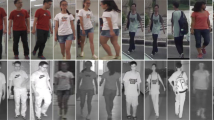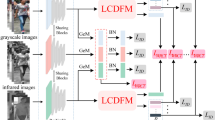Abstract
Visible–infrared cross-modality person re-identification is a realistic problem of person re-identification. Under poor illumination scenario, general methods of visible–visible person re-identification can not solve the problem well. If we directly compare the visible images of pedestrians captured under dark lighting with the visible images of pedestrians captured under normal light, this extreme color deviation will greatly reduce the recognition ability of the learned representations. In this paper, we propose a dual-path framework for visible–infrared cross-modality person re-identification based human part level features. Feature learning module contains modality-specific dual-path layers and modality-shared human part-level layers, which achieve discriminative global and local representations. In order to better optimize the proposed network, we design a global loss function and a local loss function for the global features and local features, respectively. The two loss functions are integrated together to train the network. We verify the effectiveness of our method on the challenging benchmarks: SYSU-MM01 and RegDB. Experimental results show that, compared with other cross-modality methods, our method has better effect in improving visible–infrared cross-modality person re-identification tasks.




Similar content being viewed by others
References
Zheng L, Shen L, Tian L, Wang S, Wang J, Tian Q (2015) Scalable person re-identification: a benchmark. In: 2015 IEEE international conference on computer vision (ICCV), Santiago, pp 1116–1124
Hu X, Jiang Z, Guo X, Zhou Y (2018) Person re-identification by deep learning muti-part information complementary. In: 2018 25th IEEE international conference on image processing (ICIP), Athens, pp 848–852
Guo Y, Cheung N (2018) Efficient and deep person re-identification using multi-level similarity. In: 2018 IEEE/CVF conference on computer vision and pattern recognition, Salt Lake City, UT, pp 2335–2344
Yu J, Tan M, Zhang H, Tao D, Rui Y (2019) Hierarchical deep click feature prediction for fine-grained image recognition. In: IEEE transactions on pattern analysis and machine intelligence
Yu J, Zhu C, Zhang J, Huang Q, Tao D (2020) Spatial pyramid-enhanced NetVLAD with weighted triplet loss for place recognition. IEEE Trans Neural Netw Learn Syst 31(2):661–674
Yu J, Li J, Yu Z, Huang Q (2019) Multimodal transformer with multi-view visual representation for image captioning. In: IEEE transactions on circuits and systems for video technology
Yu J, Tao D, Wang M, Rui Y (2015) Learning to rank using user clicks and visual features for image retrieval. IEEE Trans Cybern 45(4):767–779
Wu A, Zheng W, Yu H, Gong S, Lai J (2017) RGB-infrared cross-modality person re-identification. In: 2017 IEEE international conference on computer vision (ICCV), Venice, pp 5390–5399
Kang JK, Hoang TM, Park KR (2019) Person re-identification between visible and thermal camera images based on deep residual CNN using single input. IEEE Access 7:57972–57984
Ye M, Lan X, Li J, Yuen PC (2018) Hierarchical discriminative learning for visible thermal person re-identification. In: AAAI
Ye M, Wang Z, Lan X et al (2018) Visible thermal person re-identification via dual-constrained top-ranking. In: International joint conference on artificial intelligence, pp 1092–1099
Ye M, Lan X, Wang Z, Yuen PC (2020) Bi-directional center-constrained top-ranking for visible thermal person re-identification. IEEE Trans Inf Forensics Secur 15:407–419
Feng Z, Lai J, Xie X (2020) Learning modality-specific representations for visible-infrared person re-identification. IEEE Trans Image Process 29:579–590
Li B, Wu X, Liu Q, He X, Yang F (2019) Visible infrared cross-modality person re-identification network based on adaptive pedestrian alignment. IEEE Access 7:171485–171494
Dai P, Ji R, Wang H et al (2018) Cross-modality person re-identification with generative adversarial training. In: International joint conference on artificial intelligence, pp 677–683
Wang Z, Wang Z, Zheng Y et al (2019) Learning to reduce dual-level discrepancy for infrared-visible person re-identification. In: Computer vision and pattern recognition, pp 618–626
Wang G, Zhang T, Cheng J, Liu S, Yang Y, Hou Z (2019) RGB-infrared cross-modality person re-identification via joint pixel and feature alignment. In: The IEEE international conference on computer vision (ICCV)
Yun-Bo Zhao, Jian-Wu Lin, Qi Xuan, Xugang Xi (2019) HPILN: a feature learning framework for cross-modality person re-identification, IET Image Processing, p. 2897-2904
Hao Y, Wang N, Jie L et al (2019) HSME: hypersphere manifold embedding for visible thermal person re-identification. In: National conference on artificial intelligence, 2019, vol 33(01), pp 8385–8392
Zhang P, Xu J, Wu Q, Huang Y, Zhanga J (2019) Top-push constrained modality-adaptive dictionary learning for cross-modality person re-identification. IEEE Trans Circuits Syst Video Technol. https://doi.org/10.1109/TCSVT.2019.2939564
Hermans A, Lucas B, Bastian L (2017) In defense of the triplet loss for person re-identification. arXiv:Computer Vision and Pattern Recognition
He K, Zhang X, Ren S, Sun J (2016) Deep residual learning for image recognition. In: 2016 IEEE conference on computer vision and pattern recognition (CVPR), Las Vegas, NV, pp 770–778
Wang G, Yuan Y, Chen X et al (2018) Learning discriminative features with multiple granularities for person re-identification. In: ACM multimedia, pp 274–282
Dai J et al (2017) Deformable convolutional networks. In: 2017 IEEE international conference on computer vision (ICCV), Venice, pp 764–773
Zeiler MD, Taylor GW, Fergus R (2011) Adaptive deconvolutional networks for mid and high level feature learning. In: 2011 International conference on computer vision, Barcelona, pp 2018–2025
Maas AL, Hannun AY, Ng AY (2013) Rectifier nonlinearities improve neural network acoustic models. In: ICML workshop on deep learning for audio, speech and language processing
Deng JK, Guo J, Xue NN, Zafeiriou S (2019) ArcFace: additive angular margin loss for deep face recognition. In: Computer vision and pattern recognition
Nguyen DT, Hong HG, Kim KW, Park KR (2017) Person recognition system based on a combination of body images from visible light and thermal cameras. Sensors 17(3):605
Moon H, Phillips PJ (2001) Computational and performance aspects of PCA-based face-recognition algorithms. Perception 30(3):303–321
Xiang X, Lv N, Yu Z, Zhai M, El Saddik A (2019) Cross-modality person re-identification based on dual-path multi-branch network. IEEE Sens J 19(23):11706–11713
Xiao T, Li H, Ouyang W, Wang X (2016) Learning deep feature representations with domain guided dropout for person re-identification. In: 2016 IEEE conference on computer vision and pattern recognition (CVPR), Las Vegas, NV, pp 1249–1258
Liao S, Hu Y, Zhu X et al (2015) Person re-identification by local maximal occurrence representation and metric learning. In: IEEE conference on computer vision and pattern recognition (CVPR), pp 2197–2206
Dai Z, Chen M, Zhu S, Tan P (2018) Batch feature erasing for person re-identification and beyond. arXiv preprint arXiv:1811.07130
Author information
Authors and Affiliations
Corresponding author
Additional information
Publisher's Note
Springer Nature remains neutral with regard to jurisdictional claims in published maps and institutional affiliations.
This work was supported in part by the National Natural Science Foundation of China under Grant 61401113, in part by the Natural Science Foundation of Heilongjiang Province of China under Grant LC201426, and in part by the Fundamental Research Funds for the Central Universities of China under Grant 3072019CF0801.
Rights and permissions
About this article
Cite this article
Xiang, X., Lv, N., Zhai, M. et al. Dual-Path Part-Level Method for Visible–Infrared Person Re-identification. Neural Process Lett 52, 313–328 (2020). https://doi.org/10.1007/s11063-020-10239-2
Published:
Issue Date:
DOI: https://doi.org/10.1007/s11063-020-10239-2




